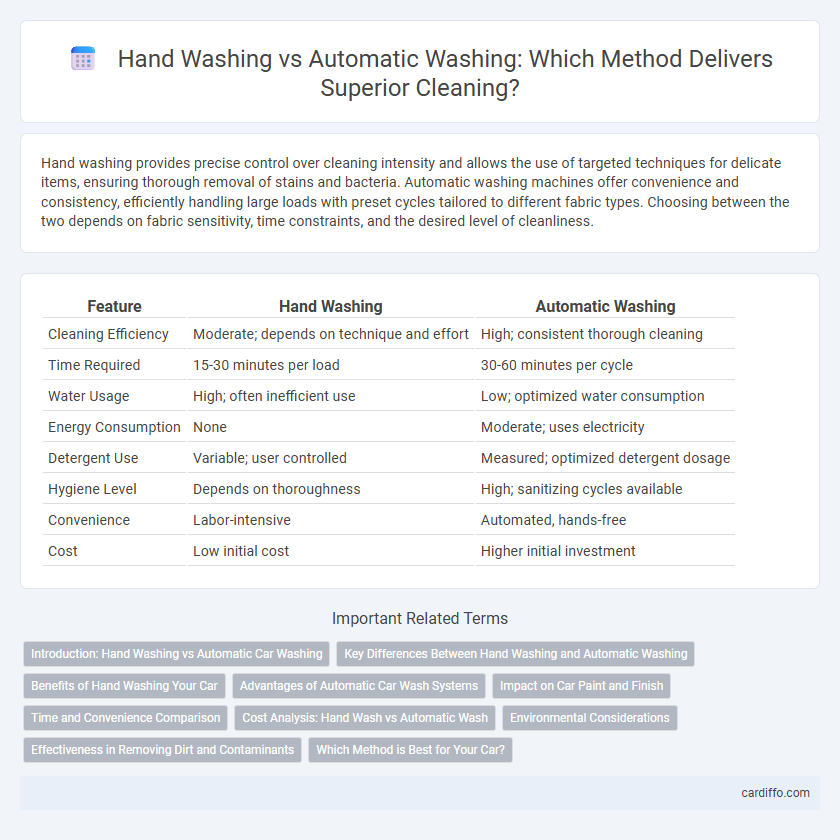Hand washing provides precise control over cleaning intensity and allows the use of targeted techniques for delicate items, ensuring thorough removal of stains and bacteria. Automatic washing machines offer convenience and consistency, efficiently handling large loads with preset cycles tailored to different fabric types. Choosing between the two depends on fabric sensitivity, time constraints, and the desired level of cleanliness.
Table of Comparison
| Feature | Hand Washing | Automatic Washing |
|---|---|---|
| Cleaning Efficiency | Moderate; depends on technique and effort | High; consistent thorough cleaning |
| Time Required | 15-30 minutes per load | 30-60 minutes per cycle |
| Water Usage | High; often inefficient use | Low; optimized water consumption |
| Energy Consumption | None | Moderate; uses electricity |
| Detergent Use | Variable; user controlled | Measured; optimized detergent dosage |
| Hygiene Level | Depends on thoroughness | High; sanitizing cycles available |
| Convenience | Labor-intensive | Automated, hands-free |
| Cost | Low initial cost | Higher initial investment |
Introduction: Hand Washing vs Automatic Car Washing
Hand washing a car involves manually scrubbing with sponges and brushes, allowing for detailed attention to dirt and grime in hard-to-reach areas. Automatic car washing uses mechanized brushes, jets, and dryers, providing a faster and more consistent cleaning process. Choosing between methods depends on factors like time availability, desired thoroughness, and potential surface damage risks.
Key Differences Between Hand Washing and Automatic Washing
Hand washing uses manual scrubbing with soap and water, allowing targeted cleaning for delicate or heavily soiled items but often requires more time and effort. Automatic washing employs machines with preset cycles that control water temperature, agitation, and spin speed, ensuring consistent cleaning efficiency and saving time. Key differences include water usage, cleaning consistency, energy consumption, and suitability for different fabric types.
Benefits of Hand Washing Your Car
Hand washing your car offers precise control over the cleaning process, allowing you to target stubborn dirt and delicate areas without causing damage to the paintwork. It reduces the risk of swirl marks and scratches often caused by automatic washing machines using abrasive brushes. Hand washing also enables the use of specialized cleaning products tailored to your vehicle's specific needs, ensuring a thorough and personalized clean.
Advantages of Automatic Car Wash Systems
Automatic car wash systems offer significant advantages by providing consistent, thorough cleaning with minimal water usage compared to manual hand washing. They save valuable time and reduce physical effort while using advanced brushes and high-pressure jets to remove dirt and grime efficiently. These systems also minimize the risk of paint scratches and environmental contamination through controlled detergent application and wastewater recycling features.
Impact on Car Paint and Finish
Hand washing a car allows for gentle attention to detail, minimizing the risk of scratches and swirl marks that can damage the paint and finish. Automatic washing systems often use harsh brushes and strong chemicals, which may accelerate paint dulling and degradation over time. Choosing hand washing helps preserve the vehicle's glossy finish and prolongs the overall lifespan of the paint protection.
Time and Convenience Comparison
Hand washing clothes typically requires 30 to 60 minutes per load, including scrubbing and rinsing, while automatic washing machines complete cycles in 30 to 45 minutes with minimal user effort. Automatic machines offer greater convenience by allowing multitasking during wash cycles and reducing physical labor. Time efficiency and ease make automatic washing the preferred choice for busy households seeking consistent cleaning results.
Cost Analysis: Hand Wash vs Automatic Wash
Hand washing typically incurs lower upfront costs but demands significant time and labor, impacting overall efficiency. Automatic washing systems involve higher initial investment and maintenance expenses but offer consistent cleaning quality and reduced labor costs over time. Evaluating total cost of ownership reveals that automatic washing often provides better long-term savings despite the initial expenditure.
Environmental Considerations
Hand washing consumes significant amounts of water and often involves harsh detergents that can harm aquatic ecosystems, while automatic washing machines are designed to optimize water usage and reduce chemical runoff. Energy-efficient washers use less electricity compared to the combined energy expenditure in heating water manually for hand washing. Choosing automatic washing with eco-friendly detergents and energy-saving settings substantially lowers environmental impact by conserving water, reducing pollution, and minimizing carbon footprints.
Effectiveness in Removing Dirt and Contaminants
Hand washing effectively removes visible dirt and contaminants through mechanical scrubbing, but its efficiency highly depends on technique and thoroughness. Automatic washing machines use controlled temperatures, detergents, and agitation cycles to consistently eliminate dirt, oils, and microorganisms from fabrics. Studies show that automatic washing achieves higher and more reliable contaminant removal, especially in sterilizing clothes and maintaining hygiene standards.
Which Method is Best for Your Car?
Hand washing offers precise control over cleaning delicate areas and minimizes the risk of paint damage, making it ideal for luxury or older vehicles requiring gentle care. Automatic washing provides convenience and speed, using high-pressure jets and rotating brushes to efficiently remove dirt, but can potentially cause scratches or miss stubborn grime in tight spots. For optimal car maintenance, combining regular automatic washes with occasional detailed hand washing ensures thorough cleanliness and paint protection.
hand washing vs automatic washing Infographic

 cardiffo.com
cardiffo.com